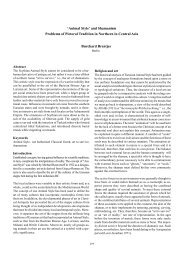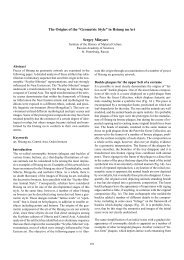Part II Archaeological Excavations - Center for the Study of Eurasian ...
Part II Archaeological Excavations - Center for the Study of Eurasian ...
Part II Archaeological Excavations - Center for the Study of Eurasian ...
You also want an ePaper? Increase the reach of your titles
YUMPU automatically turns print PDFs into web optimized ePapers that Google loves.
Kurgans, Ritual Sites, and Settlements: <strong>Eurasian</strong> Bronze and Iron Age<br />
Sea maritime zone, while to <strong>the</strong> south it is defined by Lake<br />
Sarykamysh and <strong>the</strong> Uzboi Valley. 1 A wide depression (a dried<br />
up sea bay) separates <strong>the</strong> Ustyurt Plateau from <strong>the</strong> Caspian Kara<br />
Bogaz Gol (bay) and <strong>the</strong> low Mangyshlak plateau to <strong>the</strong> west;<br />
<strong>the</strong> nor<strong>the</strong>rn edge <strong>of</strong> <strong>the</strong> Ustyurt Plateau is not steep and gradually<br />
merges into <strong>the</strong> Caspian Sea lowland valleys.<br />
No lakes, rivers, or mature vegetation are on <strong>the</strong> Ustyurt, but<br />
sweet and salty water is obtained from deep wells. The current<br />
ecological situation <strong>of</strong> <strong>the</strong> plateau is extremely harsh; essentially<br />
<strong>the</strong>re is no rain, and during <strong>the</strong> summer <strong>the</strong> temperature<br />
can reach up to 47 degrees celsius. In winter it is virtually impossible<br />
to survive on <strong>the</strong> plateau due to <strong>the</strong> constant strong<br />
winds and temperatures dropping as low as 30 degrees celsius.<br />
The severe climatic conditions in Ustyurt have changed little<br />
over <strong>the</strong> last three thousand years and consequently, because<br />
<strong>of</strong> <strong>the</strong> harsh environment, it is generally assumed it would have<br />
been impossible <strong>for</strong> large populations to have lived on <strong>the</strong> plateau<br />
during <strong>the</strong> Early Iron Age. The discovery <strong>of</strong> two archaeological<br />
sanctuary sites on western Ustyurt near <strong>the</strong> Baite Wells<br />
in 1983, preliminarly dated to between <strong>the</strong> 4 th –2 nd centuries BC,<br />
was completely unexpected.<br />
Site description<br />
Analysis <strong>of</strong> <strong>the</strong> Baite sanctuaries has revealed that <strong>the</strong>y are<br />
a unique complex <strong>of</strong> sites <strong>of</strong> a type previously unknown<br />
throughout <strong>the</strong> <strong>Eurasian</strong> steppes. <strong>Archaeological</strong> expeditions<br />
conducted over several years in western Ustyurt and<br />
Mangyshlak have discovered more than a dozen o<strong>the</strong>r sanctuaries<br />
similar to <strong>the</strong> Baite examples. These o<strong>the</strong>r complexes<br />
are less impressive than <strong>the</strong> Baite sanctuaries in terms <strong>of</strong><br />
size and <strong>the</strong> number <strong>of</strong> statues (Samashev and Olkhovskiy<br />
1996; Olkhovskiy and Galkin 1997). All <strong>of</strong> <strong>the</strong> sanctuaries<br />
display a number <strong>of</strong> common features including <strong>the</strong>ir location<br />
on hills; <strong>the</strong> existence <strong>of</strong> one to five mounds or moundshaped<br />
embankments; up to 35 stone anthropomorphic statues;<br />
round and rectangular stone altars; and dozens <strong>of</strong> small<br />
stone sacrificial memorial structures (Olkhovskiy and<br />
Galkin 1990). By <strong>the</strong> time <strong>the</strong> sites were discovered all <strong>the</strong><br />
statues had fallen from <strong>the</strong>ir original positions and a large<br />
number appear to have been deliberately destroyed. It is<br />
possible that some <strong>of</strong> <strong>the</strong> destruction may have occurred<br />
during antiquity.<br />
The sanctuaries<br />
The discovery <strong>of</strong> <strong>the</strong> Baite sanctuaries has raised a number <strong>of</strong><br />
important questions, namely who, when, and <strong>for</strong> what purpose<br />
were <strong>the</strong>se sanctuaries created in an almost inaccessible desert,<br />
far from <strong>the</strong> centers <strong>of</strong> <strong>the</strong> ancient civilizations? The sites are<br />
also important as repositories <strong>for</strong> an expressive anthropomorphic<br />
art style. Previously it was thought that <strong>the</strong> Sarmatian,<br />
Saka, and Massagetae tribes, who lived in <strong>the</strong> western Asian<br />
steppes, were familiar only with “Animal Style.” The results<br />
<strong>of</strong> a research program conducted over a several decades by a<br />
joint Russian-Kazakhstan expedition has enabled us to gain<br />
valuable insights into <strong>the</strong>se issues.<br />
34<br />
Plans <strong>of</strong> <strong>the</strong> sanctuaries Baite <strong>II</strong>I, Teren, and Karamunke indicate<br />
that a round cultic construction up to 10 m in diameter, or<br />
a large mound, was <strong>the</strong> main structural features <strong>of</strong> <strong>the</strong> sanctuaries<br />
(Fig. 2). The cultic structures were composed <strong>of</strong> large<br />
stone blocks that <strong>for</strong>med a circular wall approximately 1.5–2<br />
m in height, with a width <strong>of</strong> up to 1 m. A narrow passageway<br />
generally provided access into <strong>the</strong> interior <strong>of</strong> <strong>the</strong> structure. No<br />
remains <strong>of</strong> construction debris or household refuse was recovered<br />
from <strong>the</strong> interior <strong>of</strong> <strong>the</strong> cultic structure or from <strong>the</strong> entire<br />
sanctuary territory; thus we are <strong>of</strong> <strong>the</strong> opinion that <strong>the</strong> sanctuaries<br />
deliberately were kept clean. The circular cultic constructions<br />
have parallels with Zoroastrian dakhma, although no human<br />
bones or traces <strong>of</strong> burials synchronous with <strong>the</strong> sanctuaries<br />
have been recovered.<br />
The sculptures<br />
The anthropomorphic sculptures are <strong>the</strong> most dramatic feature<br />
<strong>of</strong> <strong>the</strong> sanctuaries (Olkhovskiy 1994). Although <strong>the</strong>y had fallen<br />
and were no longer in situ, it was possible to identify <strong>the</strong>ir original<br />
location because <strong>of</strong> <strong>the</strong>ir preserved foundation pits. It became<br />
clear that <strong>the</strong> statues had been positioned in groups composed<br />
<strong>of</strong> two to four monuments, and that each group had been<br />
located approximately 1–2 m from <strong>the</strong> next. The number <strong>of</strong><br />
sculptures located in each sanctuary ranged from one or two<br />
up to as many as 35, and a total <strong>of</strong> approximately 100 statues<br />
have been recovered. Although <strong>the</strong> majority <strong>of</strong> <strong>the</strong> statues were<br />
broken, it was possible to reconstruct most <strong>of</strong> <strong>the</strong> monuments<br />
from broken fragments. A cluster <strong>of</strong> tall statues (approximately<br />
3–4 m high), undoubtedly, would have made a strong visual<br />
impression<br />
The statues had been ra<strong>the</strong>r skillfully made, and provide evidence <strong>of</strong><br />
ancient masons’ stone working skills; <strong>the</strong> precision with which <strong>the</strong><br />
sculptors executed minute details enables one to au<strong>the</strong>ntically reconstruct<br />
<strong>the</strong> ethnographic appearance <strong>of</strong> <strong>the</strong> earliest inhabitants <strong>of</strong> <strong>the</strong><br />
Aral-Caspian steppes. In general, each sculpture represents a standing<br />
man, his right arm lowered and his left arm, clasping <strong>the</strong> stomach,<br />
is bent at <strong>the</strong> elbow (Figs. 3–6). The faces are very expressive with<br />
almond-shaped eyes; a clear cut <strong>for</strong>ehead that gradually trans<strong>for</strong>ms<br />
into an elongated straight nose; a thin drooping mustache and a small<br />
mouth. In addition, a number <strong>of</strong> <strong>the</strong> statues also have wrinkles clearly<br />
incised into <strong>the</strong> cheeks (Fig. 7). Although <strong>the</strong> majority <strong>of</strong> <strong>the</strong> sculptures<br />
display European facial characteristics, o<strong>the</strong>rs have wide flattened<br />
faces, a lack <strong>of</strong> beards, and pronounced cheek-bones, features<br />
that are characteristically Mongoloid. It should be noted that<br />
paleoanthropological studies have indicated that peoples <strong>of</strong> Europoid-<br />
Mongoloid admixture lived in <strong>the</strong> eastern Caspian region during <strong>the</strong><br />
Early Iron Age (Samashev et al 1997).<br />
Their costume and assessories are also indicated. A wide lea<strong>the</strong>r belt<br />
with a metallic buckle, sometimes decorated with embroidery or<br />
appliqué, appears to have been an obligatory element <strong>of</strong> a warrior’s<br />
outfit (Fig. 3). A double-edged sword in a sheath was hung from <strong>the</strong><br />
belt front by two straps (Figs. 5 and 6), and a gorytus (quiver) was<br />
attached to <strong>the</strong> left side <strong>of</strong> <strong>the</strong> belt. The Bow in <strong>the</strong> gorytus small and<br />
sigma-shaped (Figs. 4 and 8), and <strong>of</strong> <strong>the</strong> type typically used by <strong>the</strong><br />
<strong>Eurasian</strong> nomads during <strong>the</strong> Scythian-Sarmatian period.





